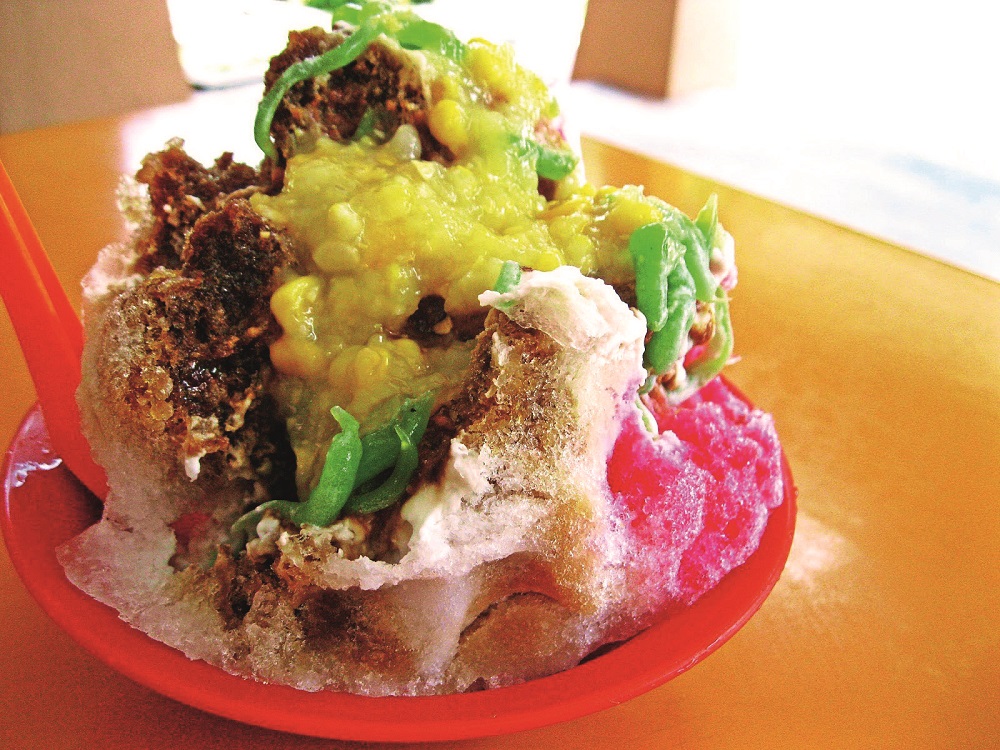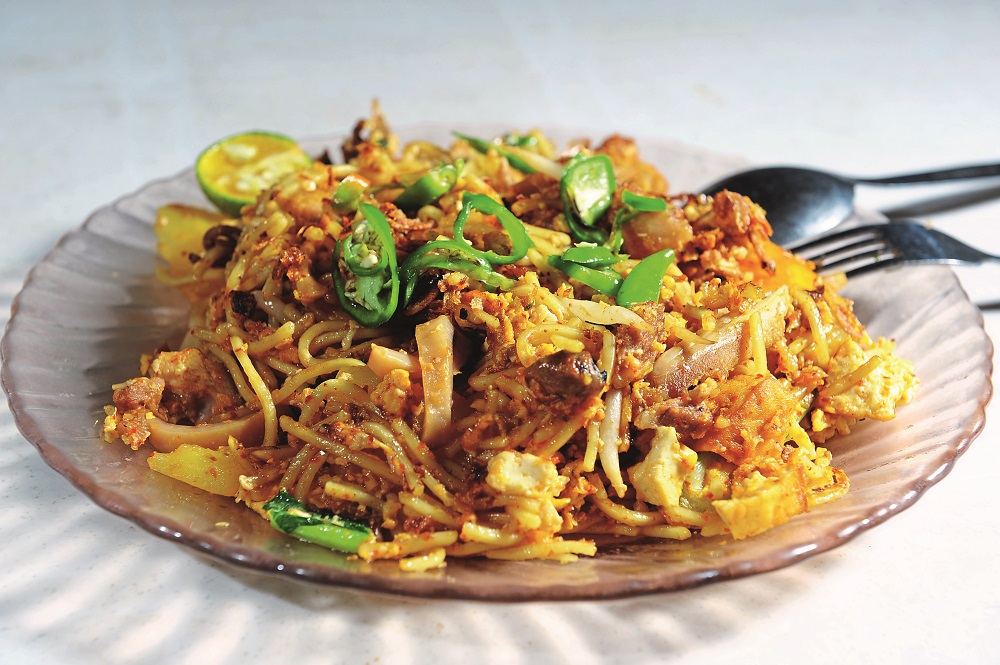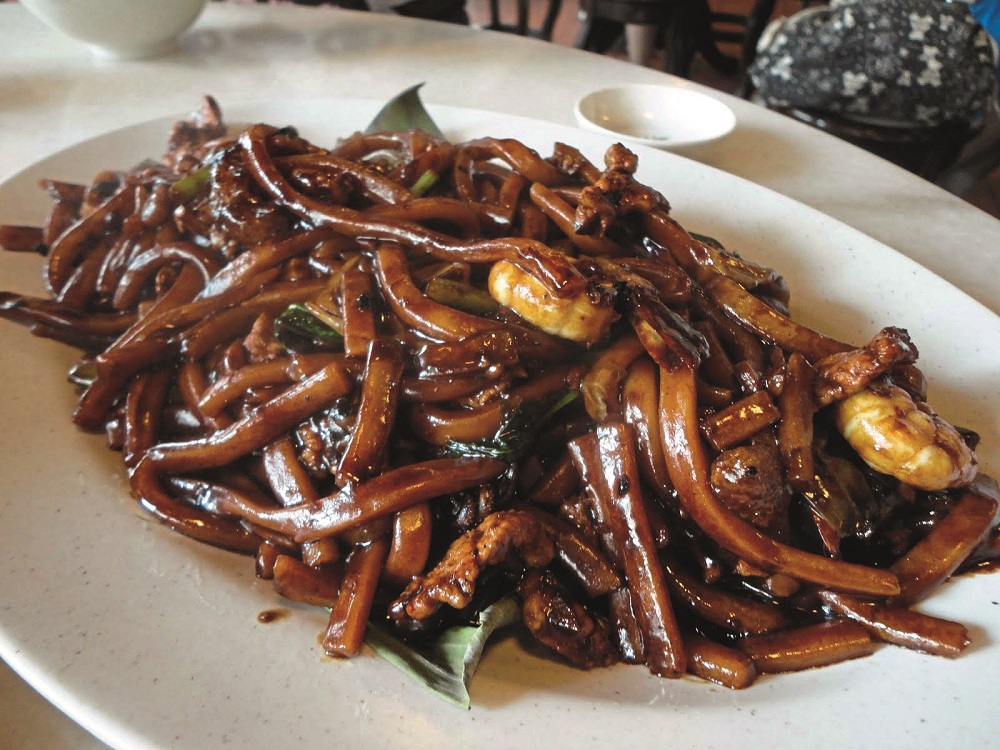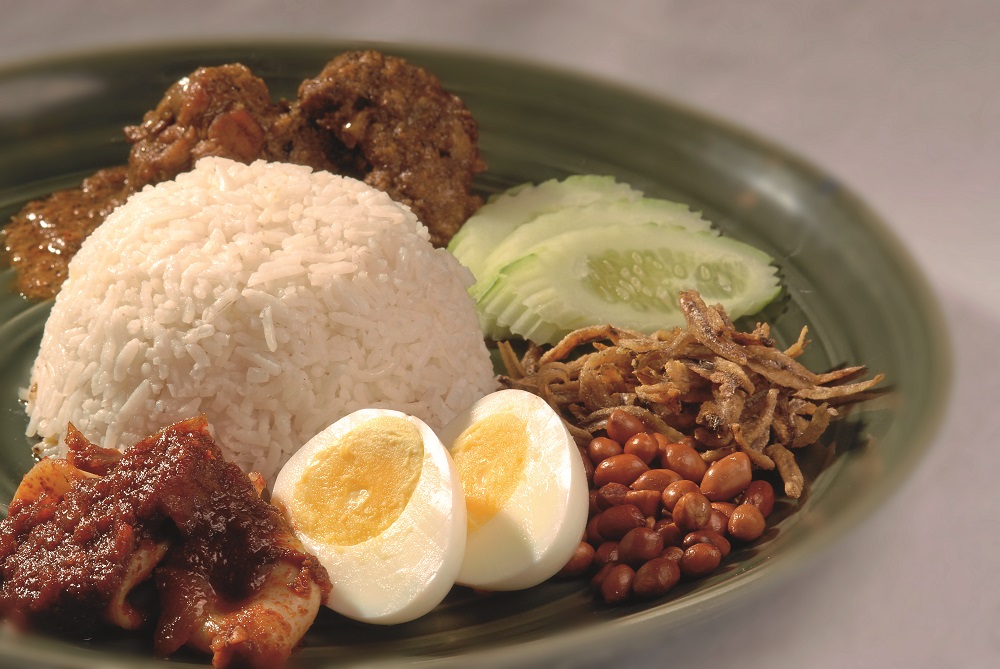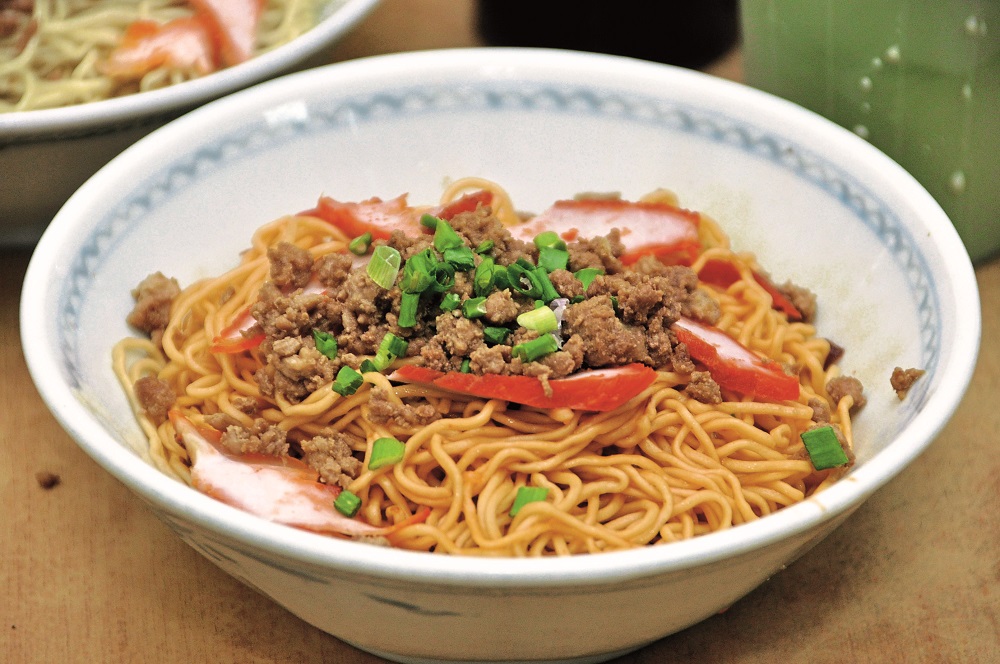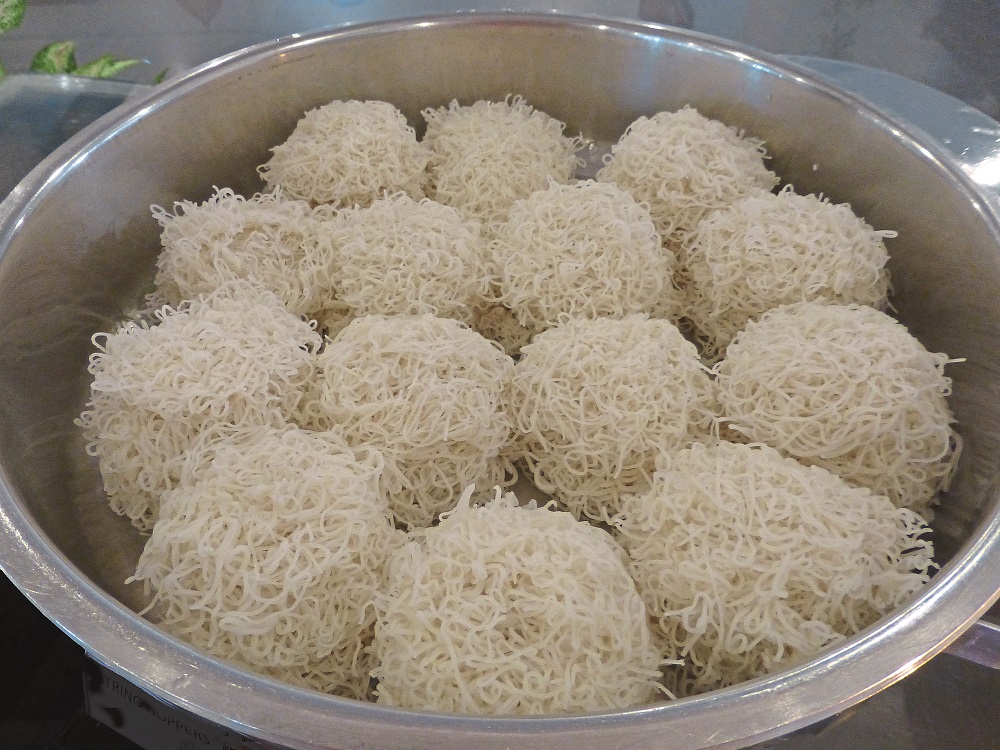One of the best things about Malaysia’s multicultural heritage is the blooming food scene – from street to fusion, and cuisines from nations around the world. Malaysia is easily one of the best destinations for food in the region. Malaysian cuisine is simply food from India, China, and Indonesia has been Malaysian-ised, sometimes modified so much that it’s no longer recognisable from the original form.
Here are some Malaysian dishes you should taste:
1. Ais Kacang
Ais kacang (“ice beans”), also commonly known as air batu campur (ABC for short, translated to mean “mixed ice”), is one of the most popular Malaysian desserts that can be found either at roadside stalls or any restaurant serving local delicacies. This deliciously refreshing dessert is made with a mound of finely shaved ice, topped with a generous portion of condiments such as grass jelly, palm seeds, red beans, peanuts, and sweet corn, then sweetened with flavoured syrup such as palm sugar syrup, sarsaparilla syrup, or rose syrup, and finally drizzled with evaporated milk.
While traditionally the dessert was only made with ice and red beans, today the varieties have expanded to include additional toppings such as ice-cream and nata de coco. It is the perfect way to cool your body down in the sultry, hot Malaysian weather!
Savouring ais kacang on a hot day is only part of the pleasure. Watching the ritual of preparation – the blending of ingredients, a spoon of this, a pinch of that, scoops of ice cream, the drizzling of syrup – is half the fun. Plus it’s completely customisable to your taste, and fun to share! So go ahead, sink your spoon into this a heavenly bowl of ais kacang and experience a unique explosion of flavours and textures that can only be found in this icy dessert
2. Mee goreng mamak
Being strategically and geographically situated along the ancient spice route has led to Malaysian cuisine being heavily influenced by various cultures namely Chinese, Indonesian, and Indian. The incredible blending of these different cultures is reflected in the rich culinary offerings. One classic example is the mee goreng mamak.
The word mamak is a colloquial term used in Malaysia to refer to the Indian-Muslim community, and thanks to them, we have famous Malaysian dishes that have gained international stardom. Closer to home, mee goreng (fried noodles) can be found everywhere and in unique variations too, from street vendors and pushcart operators to established eateries.
Some are spicy, some are not, some with potatoes and chunks of tomato, others with shrimp or scallions, but rarely are there two identical versions. It’s a dish you’re invited to personalise. Basically, mee goreng is prepared with only a handful of ingredients such as yellow noodles, egg, leafy vegetables, bean sprouts, tofu, or potato, and their homemade speciality sambal or sauce. The combination of flavours coming together in a hot wok is like pieces of puzzle falling into place to create a pretty picture; each one adds its own personality, and the result is a harmonious savoury dish that you can never get enough of, ideal for a snack or light meal.
3. KL Hokkien Mee
Originating from China’s Fujian province, the KL Hokkien Mee is one of the most popular Chinese dishes – loved by many people for a variety of reasons. Not to be confused with Penang Hokkien Mee and Singaporean Hokkien Mee, which are both lighter in colour, the KL Hokkien Mee is a staple noodle dish in Malaysia for supper time, easily found at hawker stalls and Chinese restaurants. In Kuala Lumpur, the dish is also known as black noodles, referring to the dark soya sauce used generously in this dish. It’s also sometimes called Hokkien Char Mee.
Some love it for the thick, black gravy that coats the noodles while many love it for the generous topping of crispy fried pork bits. Hokkien Mee connoisseurs will agree that a good plate of fried Hokkien Mee isn’t just about adding in the right amount of ingredients, but it also must be stir-fried over a charcoal fire to give it the right amount of wok hei (which literally means “wok breath”). Wok hei refers to the flavour and tastes imparted by a hot wok on food during stir-frying, so these dishes have a complex smoky flavour that is only achieved by cooking fresh ingredients over extreme heat, meaning that the flavour develops while simultaneously retaining the textural bite.
Typically stir-fried using fresh, yellow noodles that are thicker than the usual egg noodles, Hokkien Mee is characterised by other ingredients such as sliced pork, prawns, squid, and cabbage. Braising is the key method of cooking this dish and it is topped with crispy pork skin. It is normally served with sambal and a squeeze of kalamansi lime.
One particular eatery that is famed for its Hokkien noodle fare is the popular Kim Lian Kee, located at the crossroads of Petaling Street. With about 80 years of history, a taste of their dark noodles will reaffirm the reason for its popularity for the consistency in the rich, well-rounded flavours of the dish.
4. Nasi lemak
Locals, expats, and tourists alike would likely agree that one of the most famous Malaysian dishes is nasi lemak. The rice, infused with the rich aromas and flavours of coconut milk and pandan leaves, is a great starting point, and is the source of the dish’s name, literally “fatty rice” from the coconut milk with which the rice is cooked. But the magic doesn’t end there… it continues with an egg (either hard-boiled or fried), long thick slices of cucumber, a generous helping of fried peanuts, some crisp dried anchovies, sambal that is sweet and spicy (sometimes very spicy), and occasionally even finished with a piece of fried chicken that’s done just right. Mix everything together and what you get is a spoonful of pure gastronomical delight.
Nasi lemak, widely considered to be the unofficial national dish of Malaysia, usually comes wrapped in banana leaves that lends the dish its traditional “feel” – and perhaps imparts a bit of fragrance to the rice. Throughout the years, like most Malaysian dishes, this immensely popular dish has been tweaked to suit the myriad of cultures present in this country as well as the varying preferences of the people who both prepare and eat it.
So though the general dish will always comprise similar elements, it’s safe to say every nasi lemak will be a bit different! Realising that the rice goes well with almost anything, the original sambal is now being substituted by other gravies, such as chicken sambal and cuttlefish sambal, among others.
Some of the best places to get your daily nasi lemak fix are Nasi Lemak Bumbung at Seapark, Village Park Restaurant in Damansara Uptown, and CT Garden in Kampung Baru. The dish is typically enjoyed for breakfast in Malaysia, but with this potent blend of savoury goodness, nasi lemak is great to eat at any time of day!
5. Mee kolok
Having explored most of the popular food in and around Greater KL, we felt the time was ripe to take our search for foodie gems outside the Klang Valley and Peninsular Malaysia. Sarawak, also known as the Land of the Hornbill, has a host of popular food items that are totally different from the other side of the country, and one of the must-try foods when you are in Sarawak (particularly in Kuching) is definitely the delicious Mee Kolok.
Mee Kolok (sometimes called Kolo Mee) is a dish consisting of boiled egg noodles served with a light broth that is usually made of vinegar, pork or peanut oil, and is flavoured with garlic or shallots, topped off with minced pork and slivers of char siew, or sliced BBQ pork. (The halal version uses minced chicken instead.) Although similar to the popular wanton noodle, the two dishes are different because Mee Kolok is not drenched in dark soy sauce, and water is not added to the noodles when served. Mee Kolok can be eaten as it is served, or seasoned with a red chili sauce for those who like a little heat. Sometimes diners ask for their order to be seasoned with soy sauce, in order to give the dish a darker appearance and enhance its saltiness.
If Sarawak isn’t in your travel plans in the foreseeable future, but you still want to try a bowl of these savoury and chewy noodles, head to Chinese coffee shops or Sarawak restaurants in the Kuala Lumpur area, and chances are, you’ll get to enjoy a taste of the Sarawak signature Mee Kolok.
6. Idiyappam
Walking into a restaurant serving South Indian food, most of us expect the popular items such as a banana leaf meal, thosai, idli, and vadai, but what many don’t realise is that South Indian food is a lot more than these few items. One dish that is common yet underrated is the idiyappam or ‘string hoppers’ in English. Also known as putu mayam (usually served as a breakfast item or dessert), it is a South Indian snack of rice flour noodles, steamed and eaten with sweetened toppings such as grated coconut and gula Melaka (palm sugar), or with savoury dishes such as curry, stew, or chutney.
The preparation process begins with soaking rice in water for hours and then grinding it into flour, which is sifted for impurities before it is steamed or roasted. The rice flour is then mixed with water and salt to form a paste. Pandan leaves are sometimes used to add fragrance and flavour to the mixture. The mixture is pressed through a wooden mould, which has holes at one end, creating long, thin strands. The strands are squeezed out in a circular motion to produce round lacy pancakes, which are then steamed. It has a unique texture, mild taste, and goes well with almost anything. Today string hoppers can be seen in most Indian eateries in Malaysia and the dish is also famous in Singapore, Indonesia, and Sri Lanka.
This article was originally published in Senses of Malaysia (Jan/Feb 2017) which is available online or in print.
"ExpatGo welcomes and encourages comments, input, and divergent opinions. However, we kindly request that you use suitable language in your comments, and refrain from any sort of personal attack, hate speech, or disparaging rhetoric. Comments not in line with this are subject to removal from the site. "



